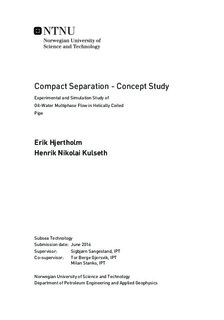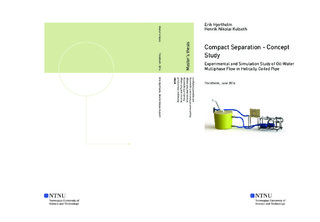| dc.description.abstract | This master thesis is written as part of a SUBPRO project whose long term goal is to identify multiphase flow separation performance of a helically coiled pipe and determine if it s viable for further industrial development. SUBPRO is an applied research center consisting of relevant contributors from the industry and the Norwegian University of Science and Technology. One of their stated goals is to «develop new knowledge and technology to meet future challenges in subsea production and processing». This thesis is a continuation of the work previously done in the specialization project «Compact Separation; Concept Study of Helically Coiled Pipe and Preparation for Experimental Setup» and will later be continued as a PhD study.
The objective of this thesis is to develop an experimental setup and conduct experiments to qualitatively determine the potential of using a helically coiled pipe as a compact separator or flow conditioner and its potential for further industrial development. In the end, recommendations based on the results is to be made. In addition, CFD simulations will be performed to support the data from the experiments.
Main work done in this project consists of:
Development of experimental setup. This includes completion of design, ordering of parts, construction, instrumentation and system testing and calibration.
Generation of CAD drawings and CFD meshing for simulations.
Simulations in Computational Fluid Dynamics.
Execution of experiments with oil-water multiphase flow with varying oil ratio and flow rates.
Simulations in Ansys CFX were performed so that numerical results that was difficult to obtain visually could be extracted. This includes separation performance, secondary flow and turbulence. The geometry used in the simulations was limited to the loop and one meter of straight section before and after the loop. Simulations were primarily done with mixture model but results from particle model simulations are also evaluated. The simulations indicated relatively low separation performance but showed a significant reduction in turbulence caused by the loop compared to a straight pipe section with the same length.
The experiments conducted featured an oil-water phase in a helically coiled pipe. Photographs were taken of the flow at the inlet and outlet of the loop for a range of oil ratios and flow rates and were used to visually identify if any phase segregation occurred. None of the photos showed any indication of phase segregation in the experimental range. The flow regime at both the inlet and outlet was identified as various degrees of emulsion were a low oil ratio gave a pink emulsion with low degree of translucency and a high oil ratio gave a reddish emulsion with some translucency. The experiments were affected by problems with emulsion buildup in the separator, especially at low oil ratios, and turbidity in the water which gave the water a white color, hence reduced contrast to the oil. Due to limited time, only one coil geometry was tested. Less comprehensive tests with air-oil flow showed segregation of these two phases as stratified flow.
The experimental study and results from the simulations gave no indications that the helical coil could be applicable as a compact separator for oil-water flows. However, due to the limited experimental range and sources of error this experimental study can t completely disprove the concept studied concept for oil-water flow. Improvements of the experimental setup including the ones mentioned in Recommendations for further work could yield other results. The results from the simulations did show a significant reduction in turbulence from the loop compared to a straight pipe which may give it applicability as a flow conditioner. | |

